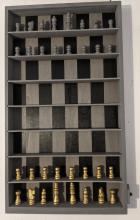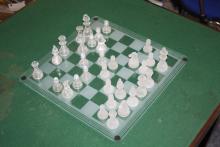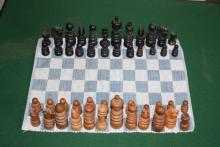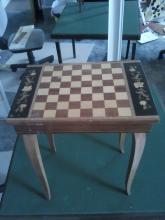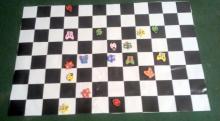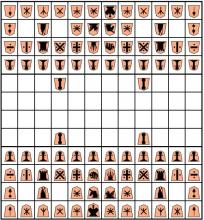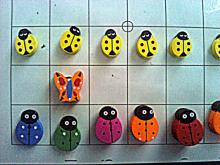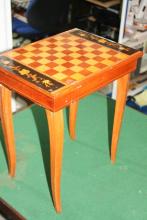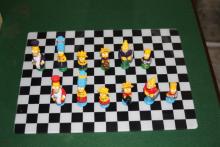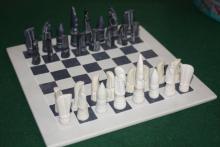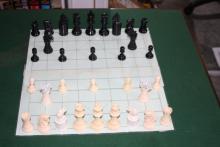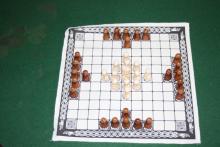Actually, I am. There comes a point (about 150) when the serious threat represented by a minority attack becomes a realistic game plan. And at master level, there is a school of thought that suggests the best way to win with the Queen's Gambit Declined as White is to play the minority attack in the Exchange Variation. I can remember several Swiss tournaments where Keith Arkell ground out a couple of his valuable wins using this line, without apparent effort. The other classic setting for the minority attack is the Sicilian Defence, and Pal Benko has been a great exponent of this winning method in the eyes of John Watson.
This session is an example of the need to study middle-games and not just openings. First of all, what is a minority attack?


















































































This is the classic setting for a minority attack. White has two Pawn islands, the larger of which is on the King's-side and you might think that White's best plan is to advance it. However, as well as exposing the White King castled King's-side, the advance would be in the teeth of Black's opposition on the e-file, and an advance of the f-Pawn would leave the e-Pawn effectively backward.
Instead, White uses a similar logic to argue that it is best to use White's own half-open file, the c-file, as the basis for an attack on the Queen's-side. White plans to advance the b-Pawn and either play b5xc6 (b7xc6), when we have a Black Pawn on c6 which is backward on an open file, or ...c6xb5, when the d-Pawn will become weak.
The advantages of a minority attack are several:
- It emerges directly from the Pawn structure
- It does not depend on the presence of Queens, and the attack can be pursued right into the endgame.
- It can work like clockwork, yielding points 'just' on technique.


















































































This is the Sicilian setting for a minority attack. White in fact has an uncompromised Queen's-side majority, and you might expect then a general Queen's-side advance. But typically pressure on the e-Pawn leads White to play Nb1-c3, in front of the c-Pawn, and Black usually nails it down with pressure on the half-open c-file.
So, encouraged by Black's lack of space and lagging development, White can punt down the King's-side, while Black can play ...b7-b5, engaging in a minority attack against the White Queen's-side Pawns.
Of course, the Sicilian is one of the most complex and flexible openings, and not all games can be interpreted in this way; nonetheless, this reading of the Pawns explains a lot of what goes on under the bonnet of Sicilian systems.
Now, I'm just having a look at playing and recommending the Orthodox Defence to the Queen's Gambit, so this the minority attack an important thing to see coming, and know how to defend against it. Let's look at the positive side of the Minority Attack first, before trying to work out what to do about it.
(817) Evans - Opsahl (CHERNEV)
[D36]
, 19501.d4 Nf6 2.c4 e6 3.Nc3 d5 4.Bg5 Nbd7 5.e3 Be7 6.Qc2 0-0 7.cxd5 exd5 8.Nf3 c6 9.Bd3 Re8 10.0-0 Nf8 11.Rab1 Ne4 12.Bxe7 Qxe7


















































































The classic setting for the minority attack.
13.b4 a6 14.a4 Nxc3 15.Qxc3 Bg4 16.Nd2 Qg5 17.Rfc1 Re6


















































































Drumming up some King's-side counterplay. Nigel Davies in a BCM article strongly recommended this idea.
18.b5 18...axb5 19.axb5 Bh3 20.g3 Rae8 21.bxc6 bxc6 22.Bf1 22...Bxf1 23.Nxf1 Ng6 24.Rb6


















































































A critical moment - if Black has to go back now he is really up against the ropes.
24...Ne7
[24...Nh4 25.Rxc6 The Rook on c6 stops the Black Rook on e6 joining the attack. I think the White King is safe here. 25...Nf3+ 26.Kh1 h5 27.Qb3 (27.Qd3) ]
25.Qb4 h5 26.Rb8 Rxb8 27.Qxb8+ Kh7 28.Qf4 28...Qxf4 29.gxf4
[The h-pawn cannot really be attacked, and with Queens off White can use the King]
29...g6 30.Nd2 Rd6 31.Kf1 Kg7 32.Ra1 Rd7 33.Nb3 Rb7 34.Nc5 Rb2 35.Ra7 Kf6 36.Ra6 Rb1+ 37.Kg2 Rb2 38.Ra7 Rb1 39.Rc7 Ra1 40.Nd3 Ke6 41.Nc5+ Kf6 42.Nd7+ Ke6 43.Nf8+ Kf6 44.Nh7+ Ke6 45.Ng5+ Kd6 46.Rb7


















































































46...f6
[46...f5]
47.Nh7 Ke6 48.Nf8+ Very neat 48...Kf7
[48...Kd6 49.Rd7#]
49.Nxg6 Kxg6 50.Rxe7 White has a pawn and hopes of collecting more. 50...Kf5 51.Rc7


















































































51...Rc1 52.Rc8 Kg6 53.Kg3 Rc2 54.h4 Kf5 55.Rh8 Kg6 56.f5+ Kxf5 57.Rxh5+
Now White has a passed pawn.
57...Kg6 58.Rh8 Kf5 59.Rg8 Rc1 60.Kg2 Ra1 61.h5 Ra7 62.Rg3 Rh7 63.Rh3 Kg5 64.Kf3
Offering to trade the pawn for a winning King raid.
64...Rh6 65.Rh1 Kf5 66.Kg3 Kg5 67.Rh4 Kf5 68.Rf4+ Kg5


















































































69.Rg4+
Again offering the pawn, but again Black dare not accept.
69...Kf5
[69...Kxh5 is rather like the game continuation: 70.Rh4+ Kg5 71.Rxh6 Kxh6 72.Kf4 Kg6 73.f3 Kg7 74.Kf5 Kf7 75.f4 Ke7 76.Kg6 Ke6 77.f5+ Ke7 78.Kg7]
70.Kh4 Rh8 71.Rg7 Ra8 72.h6 Ra1 73.Rg3 Rh1+ 74.Rh3 Rg1 75.Rf3+ Kg6 76.Rg3+
The winning clearance
76...Rxg3 77.Kxg3 Kxh6 78.Kg4 Kg6 79.Kf4 Kg7 80.Kf5 Kf7 81.f3 1-0
Here is Benko in the Sicilian version of the attack:
(30) Conrady - Benko,P [B43] minority attack in Sicilian: Dublin zt (12), 1957
1.e4 c5 2.Nf3 e6 3.d4 cxd4 4.Nxd4 a6 5.Nc3 Qc7 6.Be2 Nf6 7.0-0 Be7 8.Nb3 b5 9.Bf3 Nc6 10.g3 0-0 11.Bf4 d6 12.Bg2 Bb7 13.g4 b4 14.g5 Ne8 15.Ne2 a5


















































































"Black simply drives the pieces away and then uses the c-file pressure." - WATSON
16.Ng3 a4 17.Nd2 Nd4 18.Rc1 a3 19.b3 Rc8 20.Nc4 Nb5 21.Qg4 Nc3 22.Rfe1 Nxa2 23.Ra1 Nc3 24.Re3 e5 25.Nh5 exf4 26.Rh3 Nxe4 0-1
(31) Reyes - Benko,P [B85] minority attack in Sicilian: Lugano, 1968
1.e4 c5 2.Nf3 d6 3.d4 cxd4 4.Nxd4 Nf6 5.Nc3 e6 6.Be2 a6 7.a4 Nc6 8.0-0 Be7 9.Kh1 0-0 10.f4 Qc7 11.Bf3 Rd8 12.Nb3 b6 13.Qe1 Rb8 14.Be3 Na5 15.Rd1 Nc4 16.Bc1 b5 17.axb5 axb5 18.Ne2 e5 19.Qg3 Bb7 20.Nc3 b4 21.Nd5 Bxd5 22.exd5 e4


















































































"Isolating and winning the d-pawn." -- Watson.
23.Be2 Nb6 24.Nd4 Nfxd5 25.f5 Bf6 26.Bg5 Qc5 27.Bxf6 Nxf6 28.Rf4 Nbd5 29.Rh4 Ne7 30.Qh3 Nc6 31.Nxc6 Qxc6 32.Rc1 Qd5 33.Rd1 Qc5 34.g4 Qxc2 35.Qe3 h6 36.Rg1 Nd5 37.Qf2 Qd2 38.g5 hxg5 39.Rh5 f6 40.Qg2 Ne3 41.Qxe4 Re8 42.Qf3 g4 43.Rxg4 Nxg4 44.Bc4+ d5 0-1
Defending against a minority attack.
Now, what can you do about it? Actually, lots. Temperamentally, we might find the most appealing response in the middle-game is to deliver a mating attack on the other side. Realistically, it is helpful to combine this with other defensive methods, and to be aware of ways of counter-attacking on the Queen's-side. We shall review:
|
The King's-side counterattack, using the e-file and the e4 point. The Third-rank defence Counter-attacking on the Queen's-side:
|
The King's-side counterattack, using the e-file and the e4 point.
(826) Gligoric S - Larsen B [D36] Ch, Moscow, 1966
1.d4 d5 2.c4 e6 3.Nc3 Nf6 4.Bg5 Nbd7 5.cxd5 exd5 6.e3 c6 7.Bd3 Be7 8.Qc2 0-0 9.Nf3 Re8 10.0-0 Nf8
A move with a number of points, one of which is the exchange of the 'bad' light-squared Bishop by ...g7-g6, and then ...Nd7-d8-e6-g7 followed by ...Bf5!
11.Rab1 a5 12.a3


















































































Meeting minority attack with a King's-side attack using half-open e-file and e4 square.
12...Ne4 13.Bxe7 Qxe7 14.b4 Bf5 15.Bxe4 dxe4 16.Ne5 axb4 17.axb4 Qg5 18.Ne2 h5 19.Ng3 Bh7 20.h3 h4 21.Ne2 Ne6 22.Qb3 Bf5 23.Kh2 Qh5 24.Rbe1 Kh7 25.Nc4 Rad8 26.Nd2 Bg6 27.Nc3 f5 28.Qd1 Qg5 29.Nc4 b5 30.Na5 Rd6 31.Ne2


















































































31...f4 32.exf4 Nxf4 33.Nxf4 Qxf4+ 34.Kg1 Qf6 35.Nb3 Bf7 36.Re3 Re7 37.Rfe1 Bxb3 38.Rxb3 Rxd4 39.Qh5+ Kg8 40.Ra3 Rd8 41.Rd1 Rf8 42.Qe2 Ref7 43.f3 exf3 44.Rxf3 Qe7 45.Qxe7 Rxe7 46.Rxf8+ Kxf8 47.Rd4 g5 48.Rd6 Re1+ 49.Kf2 Rc1 50.Rd4 Ke7 51.Ke3 Ke6 52.Rg4 Rc3+ 53.Kf2 Kf5 54.Rd4 Rc4 55.Rd6 g4 56.hxg4+ Kxg4 57.Kg1 Kf5 58.Kh2 Ke5 0-1
(827) Fehmer Dirk - Khalifman Alexander [D36] It (open) (active), Eupen (Be (1), 1994
1.d4 Nf6 2.c4 e6 3.Nf3 d5 4.Bg5 Nbd7 5.cxd5 exd5 6.Nc3 c6 7.e3 Be7 8.Qc2 0-0 9.Bd3 Re8 10.0-0 Nf8 11.Rab1


















































































Meeting minority attack with a King's-side attack using half-open e-file and e4 square.
11...Ne4 12.Bxe7 Qxe7 13.b4 a6 14.a4 Ng6 15.Nd2 Nxd2 16.Qxd2 Nh4 17.Ne2


















































































17...Bh3 18.Qc2 Bxg2 19.Rfc1 Be4 20.Ng3 Nf3+ 21.Kf1 Qh4 22.Bxe4 dxe4 23.b5 axb5 24.axb5 Qh3+ 25.Ke2 Qg4 26.Kf1 h5 27.bxc6 bxc6 0-1
(828) Lipnitsky,I - Panov,V [D36] SSSR, 1952
1.d4 d5 2.c4 e6 3.Nc3 Nf6 4.Bg5 Nbd7 5.cxd5 exd5 6.e3 c6 7.Bd3 Be7 8.Nf3 0-0 9.Qc2 Re8 10.0-0 Nf8 11.Rab1 Be6 12.b4 a6 13.Na4


















































































Meeting minority attack with a King's-side attack using half-open e-file and e4 square.
In this game exchanges on e4 and d5 let the Black c-Pawn escape the Queen's-side.
13...Ne4 14.Bxe7 Qxe7 15.Bxe4 dxe4 16.Nd2 Bd5 17.Rfc1 Rad8 18.Nb6 f5 19.a4 Ng6 20.Nxd5 cxd5 21.Qc7 Rd7 22.Qg3 Rf8 23.Rc5 f4 24.Qg4 Qd6 25.a5 Rdf7 26.Rc8 Ne7 27.Rxf8+ Rxf8 28.Nf1 Nf5 29.Qd1 Qh6 30.Qb3 Qe6 31.Rc1


















































































31...f3 32.Rc5 fxg2 33.Nd2 Ne7 34.Qd1 Qh3 35.Rc7 Rf6 0-1
(52) Portisch,L - Kasparov,G [D35] Skelleftea (9), 1989
This top-flight game shows a couple of important ideas.
1.d4 d5 2.Nf3 Nf6 3.c4 e6 4.cxd5 exd5 5.Nc3 c6 6.Qc2


















































































6...Na6
The early exchange in the centre gives Black a couple of extra options, including this one.
7.a3 Nc7 8.Bg5 g6 9.e3 Bf5 10.Bd3 Bxd3 11.Qxd3 Be7 12.0-0 0-0 13.b4 Ne4 14.Bf4 Nxc3 15.Qxc3 Bd6 16.Bxd6 Nb5 17.Qb3 Nxd6


















































































This is a superb square for the Knight. well-placed for defence and attack.
18.a4 a6 19.Ne5 Re8 20.Rfe1 Qg5 21.h3 Kg7 22.Qc2 Re6 23.Rac1 Rae8 24.Qb1 Qh5 25.Qb3 f6 26.Nd3


















































































26...g5 This is Black's minority attack: White is in no position to take advantage of the loose King's-side. 27.Qd1 Qg6 28.Qc2 R6e7 29.Red1 h5 30.Qb1 h4 31.Qc2 g4 32.Nf4


















































































32...Qxc2 33.Rxc2 g3


















































































Black's attack reveals a second side: not just a King's-side hack but a Pawn attack that persists into the endgame.
34.Rd3 Kh6 35.Kf1 Kg5 36.Ne2 Nc4


















































































Black has all the pressure here, and White now sheds a Pawn.
37.Rcc3 Nb2 38.Rd2 Nxa4 39.Rb3 Nb6 40.Ng1 Nc4 41.Nf3+ Kh5 42.Rdd3 a5 43.bxa5 Ra8 44.Rd1 Rxa5 45.Re1 b5 46.Re2 Ra1+ 47.Re1 Rea7 48.fxg3 Rxe1+ 49.Kxe1 Ra1+


















































































The final assault, ironically down the Queen'-side.
50.Ke2 hxg3 51.Ne1 Ra2+ 52.Kd1 Rd2+ 53.Kc1 Re2 54.Kd1 Rxe3 55.Rxe3 Nxe3+ 56.Ke2 Nf5 57.Nc2 Nh4 58.Nb4 Nxg2 59.Kf3 Nh4+ 60.Kxg3 Nf5+ 61.Kf4 Nxd4 62.Ke3 Nf5+ 0-1
And one last recent romp:
(53) Ward,C - Sasikiran,K [D91] British (8), 1998
1.d4 Nf6 2.c4 g6 3.Nc3 d5 4.Nf3 Bg7 5.Bg5 Ne4 6.cxd5


















































































What, you might ask, is this opening doing here?
6...Nxg5 7.Nxg5 e6 8.Nf3 exd5 9.e3 0-0 10.b4


















































































A classic minority attack position from a hypermodern opening.
10...c6 11.Be2 Be6 12.0-0 a6 13.Ne1 Nd7 14.Nd3 Qe7 15.Qb3 Nb6 16.a4 Nc4


















































































This helps hold up the Queen's-side, but Black is not in a defensive frame of mind - far from it!
17.Ra2 Bf5 18.Kh1 Rfe8 19.a5 Qg5 20.Nc5


















































































20...Nxe3 21.fxe3 Rxe3
Black gets two Pawns and a raging attack.
22.Rd2 Qh4 23.Rfd1 Bh6 24.Bf1 Bf4 25.g3 Rxg3


















































































Players of a nervous disposition may wish to look away now.
26.Qb2 Bg4 27.Rd3 Rf3 28.Qg2 Rf2
The 17-year old's demolition of a former UK champion was most impressive. 0-1
The Third-rank defence
(818) Flohr,S (2500) - Apscheneek,F [D36], 1939
1.d4 d5 2.c4 e6 3.Nc3 Nf6 4.Bg5 Be7 5.e3 0-0 6.Nf3 c6 7.Qc2 Nbd7 8.cxd5 exd5 9.Bd3 Re8 10.0-0 Nf8 11.Ne5 Ng4 12.Bxe7 Qxe7 13.Nxg4 Bxg4 14.a3 Rad8 15.Rfe1 Rd6 16.Ne2 Rh6 17.Ng3 Bc8 18.b4 a6


















































































Playing ...a6 to avoid a weak a-Pawn is a sort of minimum defence of the Queen's-side by Black.
19.Rab1 Qc7 20.a4 Nd7 21.Rec1 Nf6 22.Nf1 Ne4 23.b5 axb5 24.axb5 Bd7 25.Qa2 Qd8 26.bxc6 Bxc6 27.Bb5 Rg6 28.Bxc6 bxc6


















































































"The minority attack proper has come to an end with White having inflicted a serious weakness on c6 and in fact controlling the entire left flank. It looks like a fairly simple matter systematically to attack c6 and, if not win it, then at least drive Black's pieces onto horribly passive squares. But the sequel demonstrates that matters are not to simple: Black's Rook on the third rank not only defends c6 but also creates pressure against White's King's-side" - Nigel DAVIES
29.Rb2 h5 30.Rbc2 Qd7 31.Kh1 h4 32.h3 Qf5 33.Nh2 Qg5 34.Ng4 f5 35.f4 Qh5 36.Ne5 Rg3


















































































The game approaches its climax, with both themes strongly featured in the variations - White's threats to win a Pawn and Black's threats to win a King!
37.Re1
[37.Rxc6 Rxe3 38.Qxd5+ Kh7 but White faces threats to the King]
37...Rb8 38.Kh2
[38.Rxc6 Rxe3! 39.Rxe3 Qd1+ 40.Kh2 Rb1! 41.Qa8+ Kh7 42.Rh6+! gxh6 43.Qa7+ draws]
38...Kh7 39.Nxc6
[39.Rxc6 was the last chance to play for a win 39...Qe8 but not 40.Qxd5? Rb2]
39...Qg6 40.Rg1
[40.Nxb8 Rxh3+! gives Black at least a draw 41.gxh3 Qg3+ 42.Kh1 Qxe1+ 43.Kg2 Ng3 44.Kf3 Qd1+ 45.Re2 Qh1+ 46.Rg2 Qd1+]
40...Rxe3 41.Nxb8 Qg3+ 42.Kh1 Qxf4 43.Rd1 Ng3+ 44.Kg1 1/2-1/2
Counter-attacking on the Queen's-side:
Polugaevsky, in his otherwise excellent book on the Queen's Gambit Orthodox Defence, says that it does not really matter whether the Black a-Pawn challenges the White b-Pawn on b4 by ...a5 or on b5 by ...a6. From the point of view of the opening variations that Polu was looking at, perhaps it doesn't, but from the point of view of a player handling the middle-game, it can form the basis of totally separate plans.
(a) Playing ...a5 to get an open a-file after ...a5xb4.
Arkell Keith C - Maksimenko Andrei [D35] It (open), Copenhagen (Denmar (6), 1994
1.d4 Nf6 2.Nf3 d5 3.c4 e6 4.Nc3 c6 5.cxd5 exd5 6.Bg5 h6 7.Bh4 Bf5 8.e3 Nbd7 9.Bd3 Bxd3 10.Qxd3 Be7 11.0-0 0-0 12.Rab1 a5


















































































Playing a5 to get an open a-file.
13.Qc2 Ne8 14.Bxe7 Qxe7 15.Na4 Nd6 16.Nc5 Nxc5 17.Qxc5 Qe6 18.b3 a4 19.Qb4 axb3 20.axb3


















































































20...Ra2 21.Ra1 Rfa8 22.Rxa2 Rxa2 23.Qb6 Qe7 24.Qb4 f6 25.Ne1 Kf7 26.Nd3 Ne4 27.Qxe7+ Kxe7 28.b4 Ra3 29.Nc5 Nd2


















































































30.Nxb7 Nxf1 31.Kxf1 Ra4 32.h4 Rxb4 33.Nc5 h5 34.Nd3 Rb1+ 35.Ke2 g5 36.g3 Ke6 37.Kf3 Kf5 38.Nc5 Rc1 39.hxg5 fxg5 40.g4+ hxg4+ 41.Kg3 Rh1 42.Nd3 Rh6 43.Nc5 Rh8 44.Nd3 Ra8 45.Nc5 Ra1 46.Nd3 Rg1+ 47.Kh2 Rd1 48.Nc5 Rd2 49.Kg3 Rc2 50.Nd3 Rc3 51.Nc5 Ra3 52.Nd7 Ra2 53.Nc5 Ra5 54.Nb3 Ra7 55.Nc5 Rc7 56.Nd3 Rb7 57.Nc5 Re7 58.Nd3 Rg7 59.Nc5 Rf7 60.Nd3 Rf6 61.Kg2 Rh6 62.Nc5 Rh3 63.Nd3 Rf3 64.Ne1 Rh3 65.Nd3 Rh7 66.Nc5 Kg6 67.Nd3 Re7 68.Nb4 Re6 69.Kg3 Kh5 70.Nd3 Re4 71.Nb4 Re6 72.Nd3 Re8 73.Nb4 Rc8 74.Nd3 Rc7 75.Nb4 c5 76.dxc5 Rxc5 77.Kg2 Kh4 78.Nd3 Ra5 79.Ne5 Ra6 80.Nd3 Ra2 81.Nb4 Rd2 82.Kf1 g3 83.fxg3+ Kxg3 84.Ke1 Rb2 85.Nxd5 Kf3 0-1
We'll see this ...a5 manoeuvre more than once again below, in combination with other ideas.
(b) Playing ...a6 to get a passed a-Pawn after ...c6xb5 and ...a6-a5
(820) Moutousis,K - Ruzhiale,D [D35] Manila ol (9), 1992
1.c4 e6 2.Nf3 Nf6 3.Nc3 d5 4.d4 c6 5.cxd5 exd5 6.Bg5 Be7 7.e3 Bf5 8.Bd3 Bxd3 9.Bxf6 Bxf6 10.Qxd3 Nd7 11.b4 a6


















































































Playing ...a6, and on b4-b5 exchange with the c-Pawn and push past to get a passed a-Pawn.
12.0-0 Be7 13.Rab1 0-0 14.a4 Nb6 15.Rfc1 Qd7 16.b5 cxb5 17.axb5 a5


















































































18.Ne5 Qe6 19.Qd1 Ba3 20.Rc2 Rfc8 21.Na4 Nxa4 22.Rxc8+ Rxc8 23.Qxa4 Qf5 24.Rf1 Bb4 25.Qb3 Qe6 26.Nd3 Rc4 27.Ra1 g6 28.g3 Qf5 29.Ne5 a4 30.Qd3 Qxd3 31.Nxd3 Bc3 32.Ra3 f6 33.b6 Kf7 34.Nc5 Bb4 35.Rxa4 Bxc5 36.Rxc4 dxc4 37.dxc5 c3 38.c6 c2 0-1
(c) Meeting b4-b5 with ...c6-c5, with an IQP
(822) Certek Pavel - Nikolov Sasho [D35] It (open), Prague (Czech Repu (5), 1986
1.d4 Nf6 2.c4 e6 3.Nf3 d5 4.Nc3 Be7 5.cxd5 exd5 6.Bf4 c6 7.Qc2 g6 8.e3 Bf5 9.Bd3 Bxd3 10.Qxd3 0-0 11.h3 Nbd7 12.0-0 Re8


















































































Playing ...a5 to open the a-file.
13.a3 a5 14.Qc2 Nf8 15.Rab1 Ne6 16.Bh2 Bd6 17.Bxd6 Qxd6 18.b4 axb4 19.axb4 Nd7


















































































Meeting b5 with ...c5
20.b5 c5 21.dxc5 Qxc5 22.Qd2 Nb6 23.Rfc1 Qd6 24.Rd1 Red8 25.Qb2 Na4 26.Qd2 Nxc3 27.Qxc3 Ra4 28.b6 Rc4 29.Qa5 Nc5 30.Qa3 Na4 31.Rd3 Qf6 32.Rb4 Rc3 33.Rb3 Rxd3 34.Rxd3 Nxb6 35.Qa7 Qc6 36.Nd4 Qc1+ 37.Kh2 Qc7+ 38.f4 Ra8 39.Nb5 Qc6 0-1
(821) Peelen,P - Van der Sterren,P [D36] Amsterdam Euwe-mem, 1989
1.c4 e6 2.Nc3 d5 3.d4 Nf6 4.cxd5 exd5 5.Bg5 Be7 6.e3 0-0 7.Qc2 Nbd7 8.Bd3 Re8 9.Nf3 c6 10.0-0 Nf8 11.Rab1 a5


















































































Play ...a5 to get an open a-file.
12.a3 Ng6 13.Bxf6 Bxf6 14.b4 Bg4 15.Nd2 axb4 16.axb4 Be7


















































































Meeting b5 with ...c5
17.b5 c5 18.Bf5 cxd4 19.Bxg4 dxc3 20.Qxc3 Bf6 21.Qb4 d4 22.exd4 Bxd4 23.Rbd1 Qf6 24.Bf3 Rad8 25.Ne4 Qb6 26.Rd2 Nh4 27.Rfd1 Nxf3+ 28.gxf3 Be5 29.Rxd8 Rxd8 30.Rxd8+ Qxd8 31.Qc5 Bd4 32.Qd6 Qxd6 33.Nxd6 b6 34.f4 Kf8 35.Nf5 Bc5 36.Ng3 Ke7 37.Kg2 Ke6 38.Ne4 Be7 39.Nc3 f5 40.Kf3 Bf6 41.Nd1 Bd4 42.h4 h5 43.Ne3 Bxe3 44.fxe3 Kd5 45.Ke2 Kc4 46.Kf3 Kxb5 47.e4 fxe4+ 48.Kxe4 Kc4 49.Kf5 b5 50.Kg6 b4 51.f5 b3 52.Kxg7 b2 53.f6 b1Q 54.f7 Qg1+ 55.Kh7 Qf2 56.Kg7 Kd5 57.f8Q Qxf8+ 58.Kxf8 Ke6 0-1
(d) Meeting b4-b5 with ...b7-b5, with use of the c4 square
(823) Tisdall,J - Sveshnikov,E [D35] QGD,EVd: Hastings, 1977
1.d4 Nf6 2.c4 e6 3.Nc3 d5 4.Nf3 c6 5.cxd5 exd5 6.Bg5 Bf5 7.e3 Nbd7 8.Bd3 Bxd3 9.Qxd3 Bd6 10.0-0 0-0 11.Rab1 a5 12.Qc2 Qe7 13.a3 Rfe8 14.Bh4 Qe6 15.Bg3 Bf8


















































































Meeting b4 with ...b5 to use c4 square.
16.b4 b5 17.Ne2 Nb6 18.Nf4 Qc8 19.Nd3 Nc4


















































































20.Ra1 Ne4 21.Rfc1 Re7 22.a4 Rea7 23.axb5 cxb5 24.bxa5 Rxa5 25.Rxa5 Rxa5 26.Nfe5 Qa8 27.Nd7 Ra2 28.Qb3 Ra3 29.Qb1 Nc3 30.Qc2 b4 31.Rf1 Ra2 32.Qb3 Nd2 0-1
(824) Caselas Jacobo - Antunes Antonio [D36] It (open), Mondariz (Spain), 1994
1.d4 d5 2.c4 e6 3.Nc3 c6 4.Nf3 Nf6 5.cxd5 exd5 6.Bg5 Be7 7.Qc2 g6 8.e3 Bf5 9.Bd3 Bxd3 10.Qxd3 Nbd7 11.0-0 0-0 12.Rab1 a5 13.a3 Re8 14.Qc2 Ne4 15.Bxe7 Qxe7


















































































Meeting b4 with ...b5 to use c4 square.
16.b4 Nd6 17.Nd2 axb4 18.axb4 b5 19.Ra1 Nb6 20.Nb3 Nbc4


















































































21.Qd3 f5 22.Nc5 Ra7 23.Rxa7 Qxa7 24.Rb1 Ra8 25.Qd1 Qb8 26.Ra1 Ra7 27.Nb3 Kf7 28.Rxa7+ Qxa7 29.Qa1 Qxa1+ 30.Nxa1 Ne4 31.Nd1 g5 32.f3 Ned2 33.Kf2 Ke6 34.Nc2 h5 35.Ne1 h4 36.Nd3 Nb3 37.Nc3 Na1 38.Ne1 Na3 39.Nd1 N1c2 40.Nd3 Nc4 41.g4 hxg3+ 42.hxg3 g4 43.f4 Nd2 44.Kg2 Kd6 45.Kf2 Ne4+ 46.Kg2 Kc7 47.Kh2 Kd7 48.Kg2 Kd6 49.Kh2 Na3 50.Kg2 Nc4 51.Ne5 Ncd2 52.Nf7+ Kd7 53.Ne5+ Kc7 54.Nb2 Nc3 55.Kf2 Nc4 56.Nbxc4 bxc4 57.Nf7 Ne4+ 58.Kg2 Kb6 0-1
(825) Donner,J - Hort ,V [D36] Wijk aan Zee (13), 1973
1.d4 Nf6 2.c4 e6 3.Nc3 d5 4.cxd5 exd5 5.Bg5 Be7 6.e3 c6 7.Qc2 Nbd7 8.Bd3 0-0 9.Nf3 Re8 10.0-0 Nf8 11.Rab1 a5 12.Rfc1 Ne4 13.Bxe7 Qxe7 14.a3 Ng6 15.b4 axb4 16.axb4 b5


















































































Meeting b4 with ...b5 has a downside...
17.Bxe4! dxe4 18.Nd2 Bf5 19.Ne2 Bd7 20.Nb3 h5 21.Nc5


















































































...namely, the dirty great hole on c5.
21...h4 22.Nxd7 Qxd7 23.h3 Re6 24.Ra1 Rxa1 25.Rxa1 Qd5 26.Ra8+ Kh7 27.Qc5 Qxc5 28.bxc5 f5 29.Kf1 Re7 30.Ke1 Rd7 31.Kd2 Kh6 32.Kc2 Kg5 33.Ra6 Rc7 34.Kb3 f4 35.Nc3 Kf5 36.d5 cxd5 37.Nxb5 Rb7 38.Rb6 Rxb6 39.cxb6 Nf8 40.Nd4+ Ke5 41.b7 Nd7 42.Kc3 Nb8 43.exf4+ Kxf4 44.Kb4 e3 45.fxe3+ Kg3 46.Kc5 Nd7+ 47.Kxd5 Kxg2 48.Nc6 1-0
The irony is, that with all these nifty defensive ideas being better understood, the Exchange Variation is now played in a much more flexible and dynamic way with White very often going for the advance e3-e4!
Kasparov,G (2805) - Short,N (2655) [D35] PCA-Wch01 (London) (15), 1993
1.d4 d5 2.c4 e6 3.Nc3 Nf6 4.cxd5 exd5 5.Bg5 Be7 6.e3 0-0 7.Bd3 Nbd7 8.Nge2 Re8 9.0-0 Nf8 10.b4!
Not, as you might expect, the start of a minority attack, but a way of preventing Black Queen's-side counterplay starting ...c7-c5!
10...a6
[10...Bxb4? 11.Bxf6 gxf6 12.Nxd5! (12.Qb3 Bxc3 13.Nxc3 c6 14.Qd1 f5 15.Qh5 Qf6 Gutman,L-Razuvajev,Y/URS/1976/) 12...Qxd5 13.Qa4 Bh3 14.Nf4 Qa5 15.Qxa5 Bxa5 16.Nxh3 Ne6 17.Rfd1±]
11.a3 c6 12.Qc2 g6 13.f3 Ne6 14.Bh4 Nh5 15.Bxe7 Rxe7
[15...Qxe7!?]
16.Qd2 b6? 17.Rad1 Bb7 18.Bb1 Nhg7 19.e4


















































































19...Rc8 20.Ba2 Rd7 21.Nf4 Nxf4
[21...dxe4 22.Nxe6 Nxe6 23.fxe4 Nxd4 24.Qf2 c5 (24...Ne6 25.Rxd7 Qxd7 26.Na4±) 25.Bxf7+ Kg7 26.Be6 Nxe6 27.Qf6+ Kh6 (27...Qxf6 28.Rxd7++-) 28.Qxe6±]
22.Qxf4 Ne6 23.Qe5 Re7 24.Qg3 Qc7 25.Qh4 Ng7 26.Rc1 Qd8 27.Rfd1 Rcc7 28.Na4 dxe4?
[28...Rcd7 29.e5 f5 30.exf6 Rf7 31.Bb1 Ne8 32.Re1±]
29.fxe4 Qe8?
[29...Rcd7 30.Kh1! (30.Nc3 Rxd4 31.Bxf7+ Kxf7 32.Qf2+ Nf5 33.exf5 c5„) 30...Ne6 (30...c5!?±) 31.Bxe6 Rxe6 32.Qxd8+ Rxd8 33.e5±]
30.Nc3 Rcd7 31.Qf2 Ne6 32.e5 c5 33.bxc5 bxc5 34.d5 Nd4 35.Ne4 Qd8 36.Nf6+ Kg7 37.Nxd7 Rxd7 38.Rxc5 Ne6 39.Rcc1 1-0
What to do about that approach, I can't do in much detail here, but the following game may repay study. Informator has some excellent notes.
(55) Timman,J - Yusupov,A
[D36]
Tal Memorial Tournament, Riga LAT (6), 1995
1.c4 e6 2.Nc3 d5 3.d4 Nf6 4.cxd5 exd5 5.Bg5 Be7 6.e3 0-0 7.Bd3 Nbd7 8.Nge2 Re8 9.0-0 c6 10.Qc2 Nf8 11.f3


















































































Plan B. 11...Be6 12.Rad1 Rc8 13.e4 dxe4 14.fxe4 Ng4 Black relies on piece activity to keep White's Pawns under control;
the game takes on a hypermodern air. 15.Bf4 Ng6 16.e5 Bg5 17.Bxg6 hxg6 18.Qd2 Bxf4 19.Nxf4 Bc4 20.Rfe1 c5


















































































A classic flank blow against the centre, but Black has to steer through some stormy tactics. 21.Ne4 cxd4 22.Nd6 d3 23.Nh3 Rxe5 24.Nxc8 Qxc8 25.Rxe5 Nxe5 26.Qe3 f6


















































































Black has much compensation for the exchange in the advanced Pawn and strong Knight.
27.Nf2 Bd5 28.Rc1 Qf5 29.b3 Ng4 30.Qd4 Nxf2 31.Qxf2 Qg5 32.Re1 f5 33.Qg3 Qxg3 34.hxg3 Kf7 35.Kf2 Kf6 36.Ke3 Be4 37.Rc1 a6 38.Rc7 Bxg2 1.57/1.59 1/2-1/2



